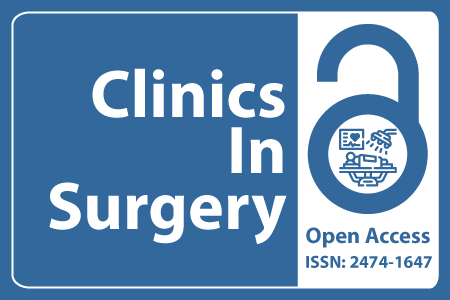
Journal Basic Info
- Impact Factor: 1.995**
- H-Index: 8
- ISSN: 2474-1647
- DOI: 10.25107/2474-1647
Major Scope
- Pediatric Surgery
- Endocrine Surgery
- General Surgery
- Surgical Oncology
- Oral and Maxillofacial Surgery
- Robotic Surgery
- Gastroenterological Surgery
- Plastic Surgery
Abstract
Citation: Clin Surg. 2017;2(1):1552.Research Article | Open Access
Transverse Flatfoot is a Potential Risk Factor for Development of Varicose Veins in the Lower Extremities of Middle-Aged Women
Bakhmetev AS, Kaliaev AO, Zotkin VV, Sukhoruchkin AA, Loiko VS and Malikova MA
Saratov State Medical University named after V. I. Razumovsky, Saratov, Russia
Avesta Central Hospitals, Saratov, Russia
Stroygrad Medical Centers, Kirsanov, Russia
Department of Surgery, Boston Universities, Boston Medical Center, USA
*Correspondance to: Malikova MA
PDF Full Text DOI: 10.25107/2474-1647.1552
Abstract
Objectives: To evaluate the effect of transverse flatfoot on the severity of varicose veins in the lower extremities (VVLE) of middle-aged women.Materials and
Methods: This was a cross sectional study which included 50 women between 39-54 years old who were scheduled for their routine care outpatient visit for their varicose vein lower extremity (VVLE) disease at the Mirotvortseva hospital, which is affiliated with Saratov State Medical University (SSMU). Both orthopedic and vascular surgeons examined all patients. Patients were excluded, if they were diagnosed prior with any of the following conditions: veins affected by thrombosis, post-thrombophlebitic disease, isolated severe varicose transformation of the main trunk of the great saphenous vein at hip level, ectasia and ultrasound signs of valvular insufficiency of the iliac and deep femoral veins, as well as women with clinical manifestations of chronic venous disease of the C4 to C6 categories by CEAP classification. All patients underwent triplex scanning (TS) ultrasound test of the lower extremities. All images were acquired on the Philips HD 11 XE scanner and expert class linear (2-5 MHz) transducer was utilized for all ultrasound tests.Results: The VVLE was found in majority of patients: out of 50 patients initially screened for this study, 48 patients have had clinics symptoms of varicose vein disease in their limbs with coexistent flatfoot condition and were included into final analysis, which had resulted in 88 lower limbs qualified after vascular surgeon clinical examinations and TS test of the lower limbs (96% participation rate). Varicose transformation of reticular or saphenous veins, corresponding to C1 category by CEAP classification, was found only in 3 out of 48 examined subjects (6%) with 6 of the lower limbs affected by venous disease. The C2 category of venous disease by CEAP classification was detected in 36 patients with 68 lower limbs out of 48 assessed subjects (75%). Clinical manifestations of C3 category of venous disease were detected in 9 women with 14 lower extremities affected (18.75%). There was no more severe degree of venous disease observed in this study. TS ultrasound of superficial and deep veins of the lower limbs revealed varicose transformation in the great saphenous vein in 43 women. In majority of cases expanded and/or incompetent perforating veins were detected (86% noted in 60 of the lower limbs). Small saphenous veins were less often affected: as observed in 8 patients only out of 48 (16%) with 10 lower limbs examined. Also noteworthy was ectasia of shin vein in 33 women (66%) with 46 of the lower limbs examined. The most common cause of deep vein extension was attributed to ectasia of medial sural veins (observed in 26 patients out of 48 (52%) with 32 of the lower limbs examined. Ectasia of soleus veins was detected in 24 patients out of 48 (48%) with 30 of the lower limbs examined.Conclusion: Transverse flatfoot is a potential risk factor in VVLE in middle-aged women. Despite an active lifestyle flatfoot was found to be associated with VVLE in 96% of cases. The main cause of VVLE was attributed to the reflux in the great saphenous vein, and in some occasions the expansion of perforators was observed. In addition, ectasia of deep shin veins was detected in 66% of analyzed subjects, which considerably affects patients’ quality of life. Based on the finding of this study women diagnosed with flatfoot and at risk for development of varicose vein disease should be screened once a year prophylactically to prevent further exacerbation of venous disease.
Keywords
Flatfoot; Varicose veins; Lower extremities; Risk factors for venous diseases
Cite the article
Bakhmetev AS, Kaliaev AO, Zotkin VV, Sukhoruchkin AA, Loiko VS, Malikova MA. Transverse Flatfoot is a Potential Risk Factor for Development of Varicose Veins in the Lower Extremities of Middle-Aged Women. Clin Surg. 2017; 2: 1552.













